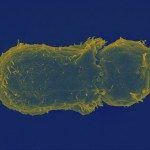Lien vers Pubmed [PMID] – 2137462
J. Biol. Chem. 1990 Mar;265(7):4131-5
The T-cell antigen receptor (TcR) complex present on most T-cells is formed by a clone-specific disulfide-linked alpha/beta heterodimer noncovalently associated to the CD3 complex, the latter composed of five invariant polypeptides: gamma, delta, epsilon, zeta/zeta, or zeta/eta. The presence of conserved, oppositely charged, amino acids in the predicted transmembrane domains of all the subunits of the TcR.CD3 complex suggests that these residues may have a critical function in the assembly and/or stabilization of the complex. In order to analyze the role of the transmembrane-charged amino acids in the association and cell surface expression of the TcR.CD3 complex, we have carried out site-directed mutagenesis of Lys271 in the transmembrane domain of the TcR beta chain and analyzed the capacity of the altered chain to assemble in a TcR beta-negative T-cell line. Here we show that substitution of this positively charged residue by alanine or glutamine does not prevent cytoplasmic association of alpha and beta chains to form disulfide-linked heterodimers, but does abolish formation of an alpha/beta.CD3 complex and, consequently, its expression on the cell surface.

